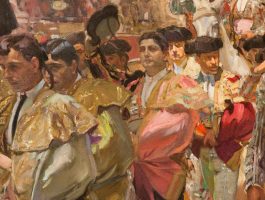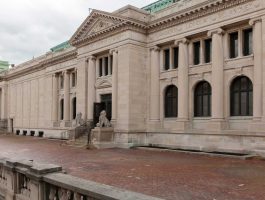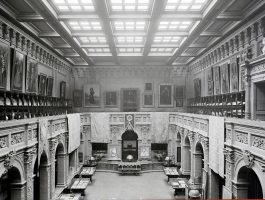The Spanish Colonial Art Gallery exhibits a selection of Latin American works from the 17th and 18th centuries. Paintings on display include the Virgin of the Immaculate Conception (Mexico, 1640) by the Dominican friar Alonso López de Herrera; The Wedding at Cana (Mexico, 1693) by Nicolás Correa, executed in the enconchado technique, a unique Mexican viceregal art form that incorporates mother-of-pearl fragments with oil painting. A Mexican casta painting from about 1720 by Juan Rodríguez Juárez provides a glimpse into the complex racial structure of viceregal Latin America in which a man, an indigenous woman, and their son are identified with the inscription “de Mestizo y de India produce coyote” (“Mestizo and Indian produce Coyote”). Also exhibited are Mexican 18th-century nun’s badges by José de Páez and Manuel de la Serna. Nun’s badges, a uniquely Mexican form, are oval or round paintings on copper with devotional images of particular significance for each nun that were worn over the habits of members of the Concepcionist and Hieronymite orders.
Works from South America include a pair of 18th-century paintings of the Cuzco School showing scenes from the life of Christ, The Flight into Egypt and The Presentation, in matching ornate gilded frames each inset with over one thousand lustrous shell fragments. From Bolivia is the painting Saint Peter of Alcántara and Saint Teresa of Avila (ca. 1700) by Melchor Pérez Holguín, one of the most prolific and idiosyncratic artists of the colonial period. Combining both decorative and sculptural elements is a section of Peruvian choir stalls (ca. 1675) from the Monastery of San Francisco, Lima. Carved from Spanish cedar (cedrela) and mahogany, the three stalls include sculptures of saints, cherubs, caryatids, and grotesque masks. Also on exhibition is a 17th-century Philippine chest made of narra wood, ornately carved in high relief with foliate and floral designs combined with birds and lions.




